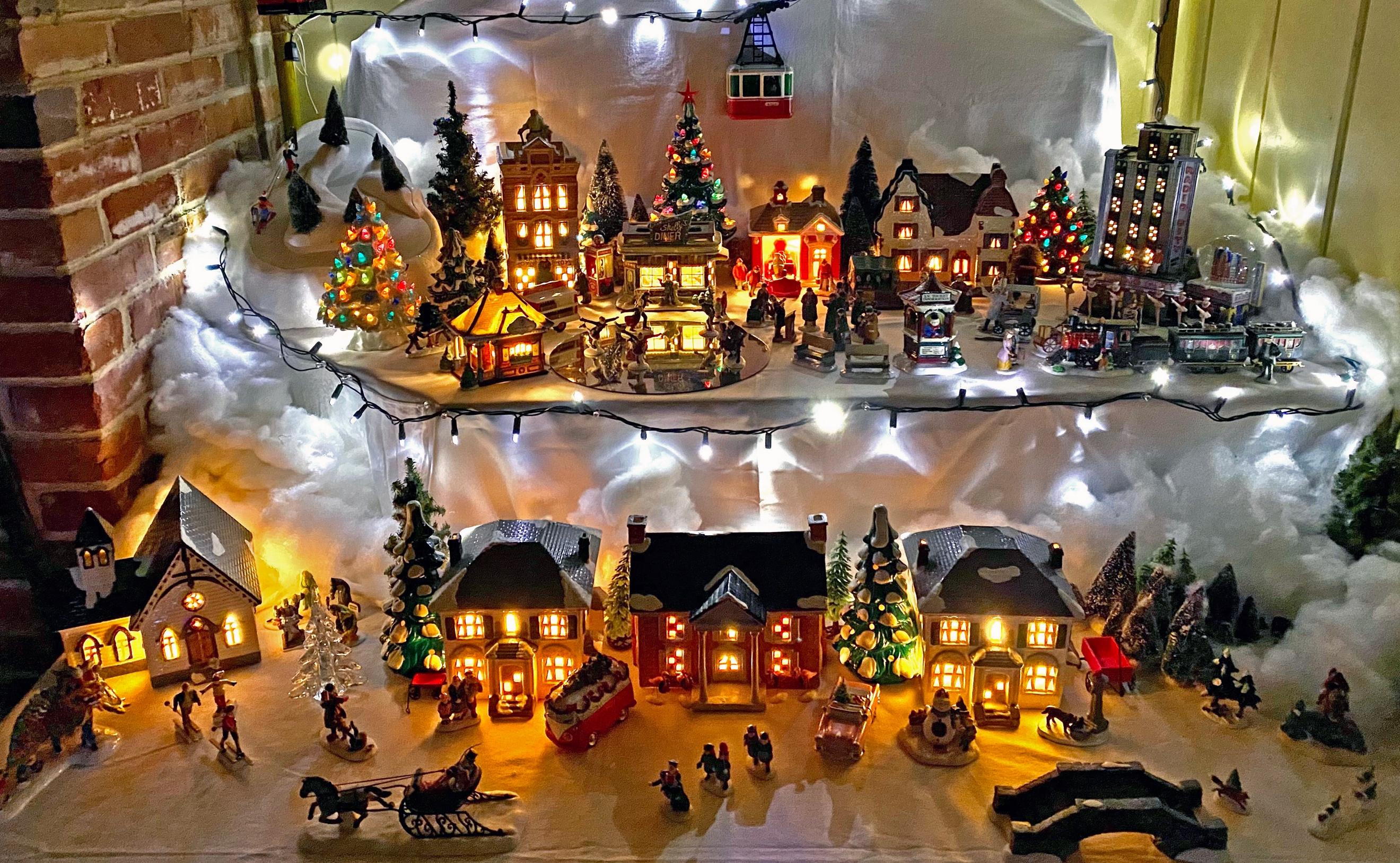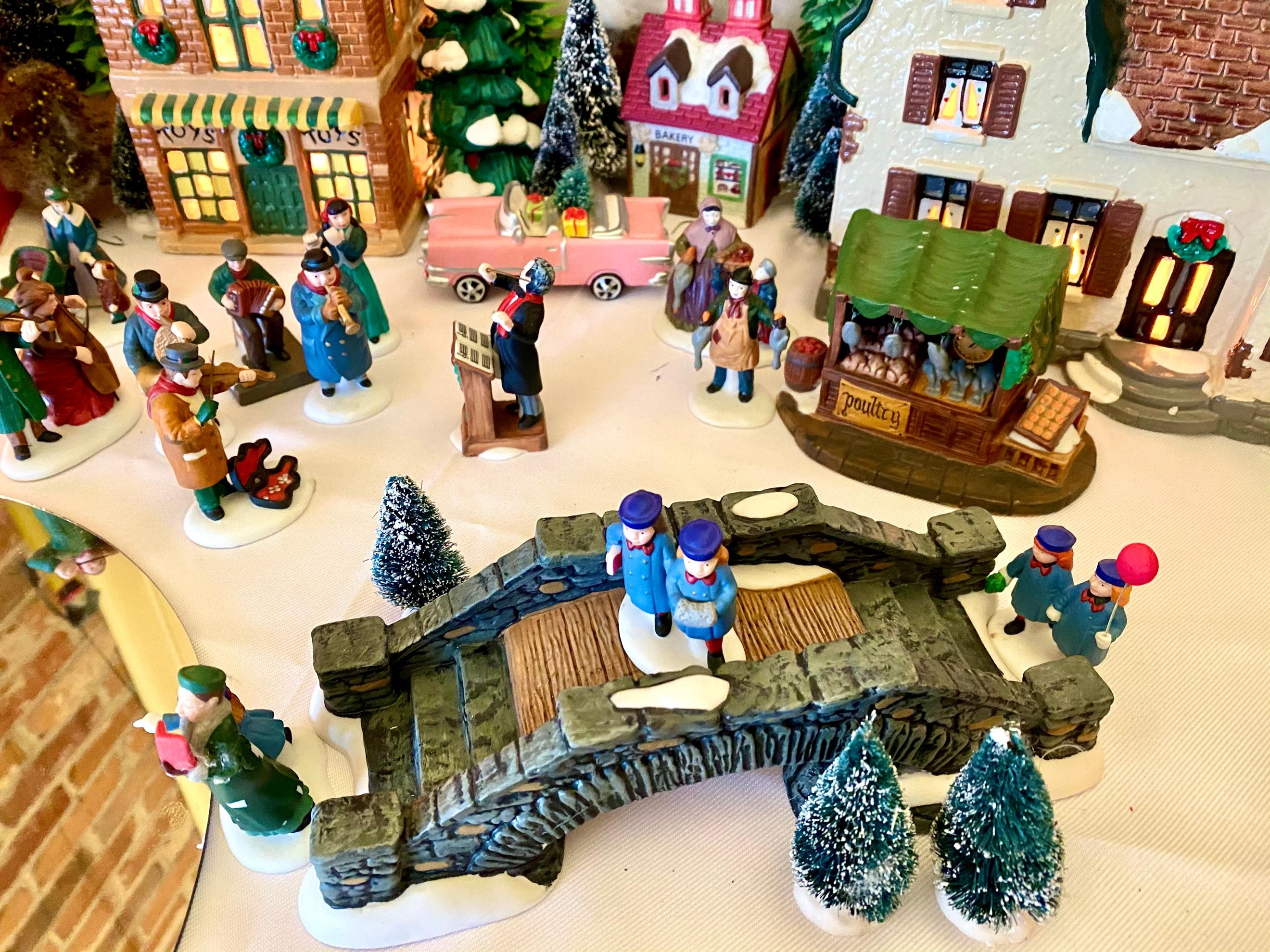
9 minute read
Madelineville John H. Ostdick
Madelineville
Advertisement
Story & Photos by John H. Ostdick
The Village of Madelineville had a modest start as an early family Christmas gift of two incongruous ceramic homes, one in the Southern Plantation Style, the other a Connecticut Dutch Colonial.
These two structures, lit by bright white bulbs inside, found a place high on the living room mantel of a small cottage in Dallas, Texas. That Christmas season, the village’s municipal jurisdiction stretched merely four feet long and eight inches deep.
In the years that followed, Madelineville (for its first years it was simply “The Village”) became more than an annual smattering of ceramic pieces. It became a tradition, a springboard of imagination and joy — and of enthusiastic expansion. Each passing year, additional characters and new structures entered the scene, often with a certain whimsy that featured an eye for fun rather than architectural or time-period symmetry. One local retailer supplied many of these; my wife, Michelle, and I found others at roadside distractions during scattered travels across the country, and/or during what we referred to as “time traveling” in the state’s collectible parlors. The seasonal town relocated from the mantel to a grouping of tables, and its

spread gained a couple of feet in each direction.
As the rich aroma of Thanksgiving turkey started to dissipate each year, like clockwork a series of muffled grunts and salty language escaped from the tiny utility room off the kitchen as I balanced awkwardly on a step ladder and stretched out to retrieve the town materials strategically packaged and crammed on shelves above the washer and dryer. Repeatedly I stepped down, ferried a couple of boxes to a small room between the kitchen and the living room, and returned for more until the floor was littered with them.
I embraced this ritual, following a couple of caveats I enforced. I was very ill for my first several Christmases, hounded by seasonal croup that relegated me to bed or dispatched me away from the festivities to a spot on a distant couch. After the doctor explained that the fresh-cut Christmas trees were the annual culprits, my allergies cursed the family with a fake silver tree each year. Nonetheless, freed from my affliction, Christmas became even more important to me — especially after becoming a parent.
My early pledge held that The Village, while ambitious, would never envelop our little “Mouse House,” as we called it. The Village layout, which changed from year to year based on whim, would always cater to a sense of flow and narrative. As a writer and editor, the idea that The Village could both retell and remake holiday stories each year (and additionally inspire the creation of a different tale to anyone who might approach it) charmed me.
Although my son, Hunter, never took any interest in the process, from her earliest years my daughter, Madeline, would drag a dinner table chair from two rooms away and perch in front of the village, studying every detail. She moved some of the characters to match a flow she perceived proper. Before long, she began naming the characters and creating backstories for them. When I realized what she was doing, it affirmed my narrative ambition for the town. I didn’t ask her to share the world she had created, at least not until years later, because I wanted it to be her personal treasure.
Although I didn’t realize it, The Village magic touched others who visited frequently during the holidays as well. One of Madeline’s best friends on the block, Bolton, would enter The Village in her own way. She identified a single skater on the ridiculously small skating rink (a circle of reflective plastic) as “Madeline,” and grudgingly identified a girl figure who was part of a skating duo as herself. “I would always want to be on my own, but that silly boy was always following me,” she would tell me years later, laughing.
The amusing detail about the two girl skaters is that they were identical twins in appearance (I considered this a laziness by the manufacturer of the skating set). And blond. Madeline had dark hair. If I had known Bolton’s narrative, I would have purchased another single female skater and painted dark hair on her. Luckily, imagination has no limits. When, as a young adult, Bolton shared this skater quandary with me, I immediately added another single female skater to the mix, ending that silly boy’s long pursuit. The need to paint one of them dark-haired was long past as well, as no one involved even noticed their blondness any longer.
The third Village player, fast friend to both Madeline and Bolton, was Meg, also bright and full of life. Meg never told a long story in her life — not that her tales were not intricate and detailed, but rather as a youth she delivered every word in her life as if it had just crested the world’s tallest rollercoaster and was headed pell-mell downhill. She danced from notion to notion like a bee, pollinating everyone’s thoughts in the room. Maybe she intuitively realized all the ground she had to cover in her life; fittingly, she eventually would be a historian.
I never figured out where Meg fit into The Village populace, although I imagined the three girls settling into a row at The Village theater, a recreation of New York’s Radio City Music Hall, feeding their voracious appetites for movies.
Whenever Meg entered the cottage, she would stop, take a deep breath, and smile serenely. “Mrs. O, your house always smells delicious,” she would often say. Indeed, the air was usually filled with intoxicating aromas. Everyone thought it fitting the year Shelly’s Café and a neighboring small bakery joined The Village menagerie (Michelle was a trained Pastry Chef by this time). I could imagine Meg sitting at a counter stool, legs swinging gently while enjoying the diner’s redolence.
One year brought the addition of an homage to children’s book author Ludwig Bemelmans’ Madeline character, a house favorite. (She was the inspiration for naming our baby girl Madeline.)
An adult woman, a la the story’s chaperone Miss Clavel, led a group of similarly dressed little girls:
In an old house in Paris that was covered with vines, lived twelve little girls in two straight lines They left the house, at half past nine... The smallest one was Madeline.

In our Village’s case, there were only four sets of two girls, all the same size. But one held a balloon floating above her. This time, it was my turn to develop a backstory, if somewhat obvious. The balloon girl was Madeline. As in the book, all the unnamed classmates wore flat sailor hats and identical coats, but Madeline stands out, not because of the way she looks, but because unlike the other girls, she is utterly fearless.
Whether that was the case or not, I thought of Madeline as fearless as well. Sometimes, I would even find myself talking to the balloon Madeline as I passed The Village, especially as my daughter grew older and was away from the house more often. It was during this time that I morphed The Village into Madelineville.
Once Madeline eventually slipped away to college, we sold our little cottage and moved to a ranch-style abode that offered room for Madelineville to spread — “putting a little more air in the landscape,” as I described it at the time. I constructed a simple plywood base with two-by-fours for legs and draped it with white cloth. The twolevel town enjoyed a renaissance of sorts.
Since that point, we have settled into a comfortable pattern. Each year, I painstakingly conjure a slightly different vintage. Most often, the off-beat collections of homes occupy upper Madelineville, and the theater, churches, stores, and skating rink the lower expanse. A ski slope, with two moving
skiers, forms the left border of town. The theater and firehouse most often hold down the right side. A gondola car hovers on an overhead cable. Pragmatic whimsy fills in all the rest.
After I finish, I text images to Madeline, who stayed in New York after graduating from NYU. She replies with praises, and occasional suggestions for changes. She zeroes in immediately if I try to eliminate one of my lesser favorite items, such as the four figures representing the three fictional Christmas Spirits who visit Ebenezer Scrooge in the 1843 novella A Christmas Carol, and demand that they return. (The characters just never seem to fit, even on this whimsical canvas, I futilely say.) When Madeline shared my Village snapshots with Bolton one year, she asked if I would start sending her a preview image each year.
Madeline’s annual return home for Christmas is a joyous event. Madelineville’s shimmering lights burn for most of the time she is there. Although she never calls it Madelineville, The Village is part of a holiday pact with me, a connection that spread to others but remains our own. Then she returns to her evolving life.
After New Year’s Day each year, I methodically deconstruct the town. The structures are tucked into their fitted boxes, the figures first wrapped in cloth for protection and then carefully stowed away as well.
The last building to be packed away is always the theater, where I imagine that the three girls sit watching old black-and-white holiday classics until the curtain falls. The three young women, living in three different states, remain fast friends.
The last characters retired each year are the skaters and Miss Clavel and girls in two lines, and finally Madeline, the little girl with the balloon.
With each passing year, I realized the time would come when Madeline would stop coming home to The Village. Each year, I hoped that year would never come. It took a society-crippling pandemic in 2020 to stop her. Madeline was determined that she would not bring a virus home to her parents, so she experienced the Christmas 2020 Madelineville, and the rest of the year’s holiday events, by Facetime or Zoom.
Everyone adapted. I erected a reduced version of Madelineville, because somehow the need for the full Village seemed less robust without Madeline. Fortunately, her brother, Hunter, who lives in town, came by and three-fourths of the family had a lovely Christmas Day. Among the many virtual events Madeline creatively shared, she and I watched a streaming movie together (in honor of the annual Christmas Day theater movie that was also part of our tradition).
During the past few years, Madeline had mentioned that while she was growing up she had created various stories for The Village residents, and I urged her to write about them. This made her uncomfortable, however. What I didn’t fathom was that the stories I imagined her developing as a youth no longer suited the adult Madeline and her life experiences. In 2020, without telling me, she labored over an adult adaptation that flowed from her many years of Village life. She presented the resulting short story, titled simply “John’s Village,” to me as her Christmas present. Frankly, her creativity overwhelmed me.
After New Year’s Day that year, retiring The Village was a little less structured. I felt the tradition had turned a corner as I put the Madeline character to rest for another year. My Madeline may not be home for every Christmas, but she will always be in Madelineville.










